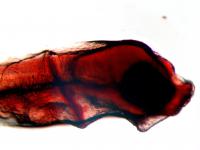Protocol for quantitative shape analysis of deformities in early larval European seabass Dicentrarchus labrax
 Published paper: Protocol for quantitative shape analysis of deformities in early larval European seabass Dicentrarchus labrax
Published paper: Protocol for quantitative shape analysis of deformities in early larval European seabass Dicentrarchus labrax
This study established an optimized protocol for quantifying the shape variation of newly hatched larvae of European seabass Dicentrarchus labrax, focusing on the effect of fixatives and mounting on body shape from hatching until 14 days post hatching, while also minimizing the error introduced by handling. This assessment was performed based on both biometric and geometric shape data, with the latter relying on outline based elliptic Fourier analysis. The fixation and mounting effect on the total length and shape of newly hatched larvae of D. labrax was tested for four fixation treatments: (1) 8% formalin, (2) 70% ethanol, (3) 8% formalin for 48 h and then to 70% ethanol and (4) 3% phosphate-buffered glutaraldehyde. The analyses showed that no significant size and shape effect was observed on anaesthetized specimens 5 months post-fixation in glutaraldehyde, and that the glycerol mounting process of specimens fixed in glutaraldehyde provided the best results for further ontogenetic qualitative and quantitative analysis. The protocol proved to be sufficiently sensitive to even quantify and visualize subtle pre-fixation shape differences originating from a different egg batch.
Authors: S. Nikolakakis, P. Bossier, G. Kanlis, K. Dierckens and D. Adriaens
Read the paper here.
Pictures:
(1) Seabass larva, 14 days after hatching. Stained with alizarin red. The dark line that appears is the start of the formation of the pectoral girdle and the cleithrum bone which will later support the pectoral fins.
(2) Seabass larva, 7 days after hatching.

